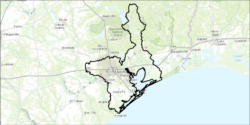

By Erin Kinney, PhD, Research Scientist, Coastal Ecology
The Houston-Galveston metropolitan region has a vibrant economy that is continually attracting new residents and businesses. Because of this thriving economy, the region’s population is expected to grow from today’s nearly 6 million people to 9 million people by 2040 with the greatest population growth expected to occur in western and northern suburban counties.

Local communities benefit from wetlands by protecting water quality and reducing the impacts of storms and floods. Wetlands also benefit the regional economy by supporting fisheries, recreation, tourism and quality of life for area residents. Population growth and associated development can―but do not necessarily have to―contribute to wetland loss in the region. By better preserving existing wetlands we can improve the region’s economy, promote a higher quality of life for residents and help address water quality and flooding issues.
By better preserving existing wetlands we can improve the region’s economy, promote a higher quality of life for residents and help address water quality and flooding issues.
In 1989, a national goal of No-Net-Loss of wetlands was established by President George H. W. Bush with the aim of protecting the services these ecosystems provide to the surrounding human and natural communities. The No-Net-Loss policy seeks to mitigate unavoidable wetland impacts resulting from development through wetland restoration or preservation. The No-Net-Loss policy is implemented through the Clean Water Act Section 404 wetland permitting and mitigation process, a key tool for protecting wetland function and ecosystem services in the Houston-Galveston region.
HARC is leading a project with the Texas Coastal Watershed Program of the Texas A&M AgriLife Extension Service to examine the long-term status of wetland permit and mitigation activities in the Lower Galveston Bay watershed. By examining the long-term status of permitted activities and mitigation projects in eight counties surrounding Galveston Bay, the project team will determine the degree to which the No-Net-Loss policy has been effective at the local and regional level.
By examining the long-term status of permitted activities and mitigation projects in eight counties surrounding Galveston Bay, the project team will determine the degree to which the No-Net-Loss policy has been effective at the local and regional level.
Decisions made at the local level have the greatest potential for protecting regional wetlands and the ecosystem services that they provide. To this end, the project team will also create a web-based decision support tool for local communities. The web-based tool will bring together available information on watershed boundaries, wetland areas, water quality impairments, impervious surface, mitigation bank service areas, and flood zones. The project team’s goal is to help local communities thrive by making informed decisions and identifying ways to preserve the value that vital wetland resources provide.
This project is funded by a grant approved by the Texas Land Commissioner pursuant to National Oceanic and Atmospheric Administration award no. NA12NOS4190021.